本田美登里
/ 西井玲子
Midori Honda / Reiko Nishii
Two years supporting the success of the national team
Taking on the world in a different culture and environment
April 19, 2024
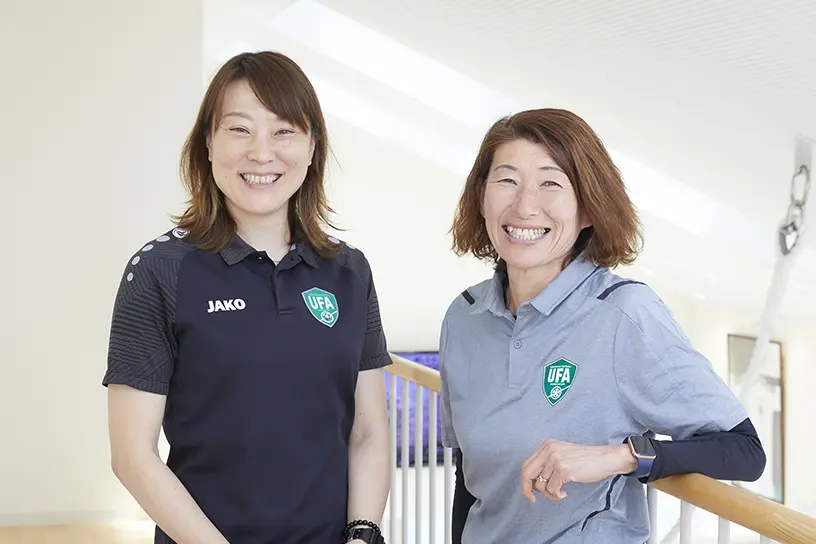
Interview: Takaya Hirano / Photos: Asako Toda
The growing importance of conditioning
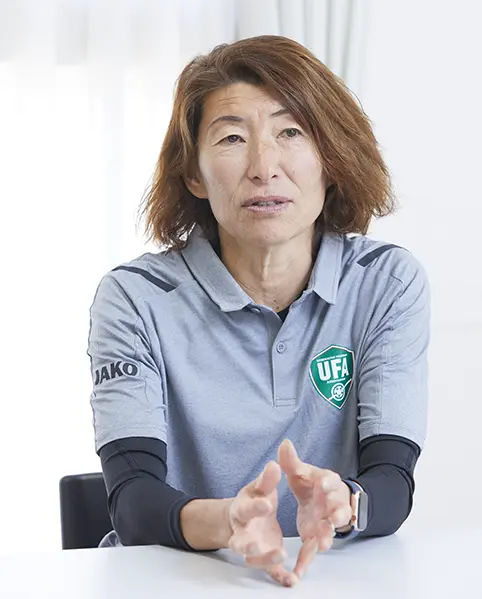
- ITO: Ms. Honda, you served the Japan women’s national team as a player. Why did you become a coach?
-
Honda: After the end of my playing career, I still wanted to be involved in promoting women’s soccer. After retiring, I joined the Japan Football Association and worked from an office supporting women’s soccer. But I felt being on the field suited me better. OKAYAMA YUNOGO BELLE approached me in 2001 about becoming the team’s coach. In contrast to the promotional activities I’d been doing to teach children the joy of soccer, I now found myself in the world of competition. A coach’s role comes with great responsibilities and decision-making power. So I continue to feel rewarded because I can realize the soccer I envision.
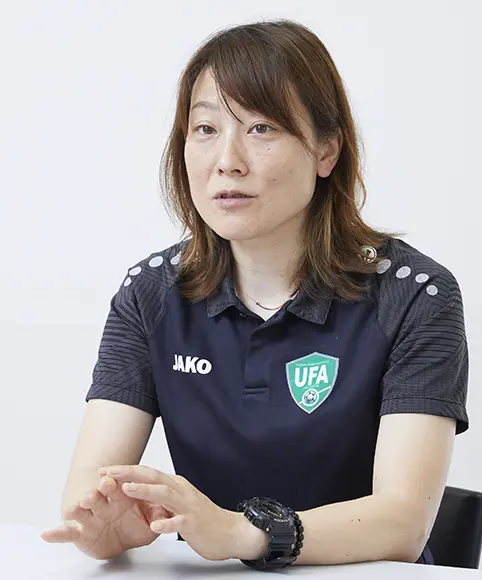
- ITO: Ms. Nishii, why did you decide to become an athletic trainer?
-
Nishii: I played basketball when I was a student. But I had lots of injuries in high school and college, so pretty often I wasn’t part of the team. Back then, there weren’t many trainers who could have helped me recover from my injuries, so that’s the sort of presence I wanted to achieve. I felt that if it was the same sport, I might end up feeling like a coach, so I started by working with the players of the soccer team at Hamakitanishi High School in Shizuoka Prefecture. Later, I worked with classical ballet dancers and softball players. All sports are the same in that they involve realizing the body’s full potential. Some emphasize endurance while others focus on agility. Coaches differ in their preferences, too. I try to come up with an approach that meets expectations.
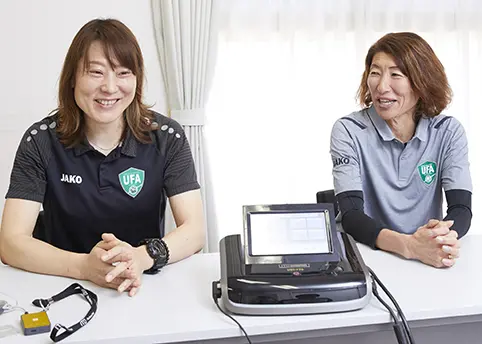
- ITO: The first time you two started working together was at SHIZUOKA SSU ASREGINA (now SHIZUOKA SSU BONITA), right?
-
Nishii: Initially it was our company (Medical Sports Meister) that was involved with the team. We had multiple trainers looking after the athletes. Before Ms. Honda, I imagined soccer practice and physical training would be handled separately. But she understood the work of the medical staff and had a clear mandate to deliver the kind of soccer she wanted.
-
Honda: At that time, I accompanied the team once a week and on games. Later I got more opportunities to work with the team. This was because many of the players had to start by strengthening their bodies as athletes, and because, given the limited number of players, the team couldn’t afford them frequently withdrawing to the sidelines, which meant they had to undergo training to prevent injuries as well.
In modern sports, teaching players how to assess their condition and how to use their bodies is as important as teaching them the sport [soccer] itself. In various areas, there are many things that have been scientifically proven, and getting the help of people with scientific expertise in body mechanics is integral to this. Even in the men’s J. LEAGUE, physical coaches and trainers are commonplace. Conditioning keeps becoming more important.
The tag team takes on a new challenge
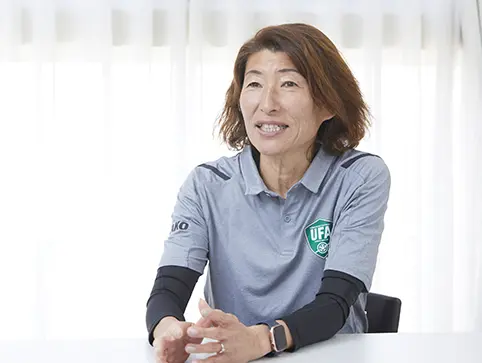
- ITO: From 2022, both of you were involved with the Uzbekistan women’s national team. How did that happen?
-
Honda: Women’s soccer is gradually spreading around the world. Opportunities are growing in the Islamic countries of West Asia. I was contacted by the Japan Football Association, which dispatches coaches overseas, mainly in Asia. They told me Uzbekistan was looking for a female coach and asked if I could do it. While I had expected they’d be aiming to qualify for international competition after six years, I was surprised to find they wanted to do it in two.
-
The way things worked, players were called up to the national team for international matches. Normally I worked on their bodies in the mornings and taught them soccer in the afternoons. One trainer could give massages, but they couldn’t come up with plans for things like physical strengthening or recovery. So, I sought advice from Ms. Nishii. But, even though I could then provide strength training, I couldn’t perform treatment, so I persuaded Medical Sports Meister to let me have Ms. Nishii for a little while.
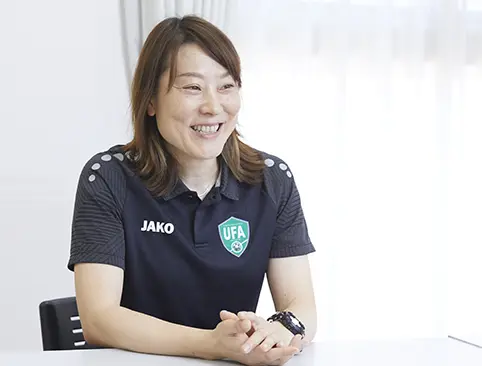
-
Nishii: I accepted, happily (laughs)! For starters, I spent about a week with the team when they traveled to Japan. It was the first time for me to work with many foreign athletes. I used a body composition analyzer called InBody to collect data, and I found they had less body fat and more muscle than I expected, which differs from Japanese athletes. When it came to treatment, I was confused from time to time. I didn’t know whether the issue had to do with expression or differences in perception, but they either said “ouch” or “okay.” There was nothing in between.
-
I went to Uzbekistan three times for about three weeks each time. There I helped with training and recovery. The idea was that for about a week I would help an injured player recover to the point they could train, then I’d work on strength training for the player for the remaining two weeks. Since the conditions of the ground and shoes differed from those in Japan, a common tendency was for inflammation following training that required agility, like quick reversals in direction. I helped them strengthen their muscles while using the treatment device, which reduced swelling and sprains.
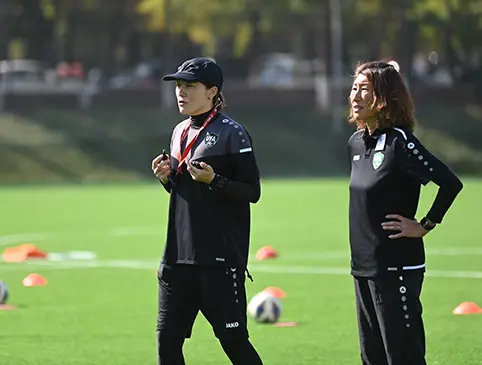
ⒸUFA
-
Honda: At times like the first round of the Asian qualifiers for the world competition, she helped us during the training period and the competition period so that the players could compete in their best possible form. Since it’s an Islamic country, they have Ramadan (fasting for about one month), and they had to practice in the heat, so it was difficult to get them into shape.
Ms. Nishii and her staffs’ strong point is that not only can they boost the physical strength of the players, but that when one of them gets injured after taking a knock during a match, they can design a recovery program to get them back into playing form. She was a great help. She understands how far the players can be pushed by using strength training and the current level of fatigue of the players. She got the players into good shape, and we didn’t need a separate physical coach and a therapist.
-
I also told the athletes, “The massage athletes need doesn’t involve oil or making you feel good. It involves checking the state of the muscles and getting them to recover (laughs).” The players didn’t like it at first, but eventually they seemed to realize they were in better condition after the massage. Eventually they started asking when Ms. Nishii would be coming again.
National team players also experienced the benefits of physiotherapy
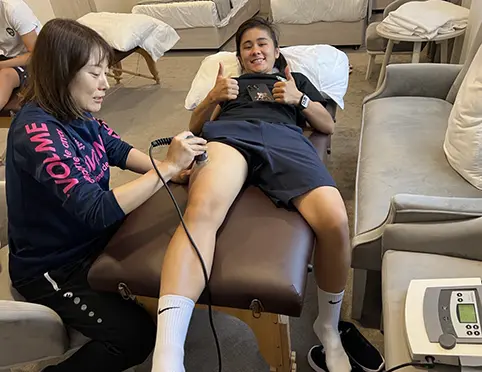
ⒸUFA
- ITO: You took your treatment device with you, right?
-
Nishii: The players from Uzbekistan were extremely sensitive. They were sensitive to stimuli not just from injuries but from acupressure, so I thought it would help to use an ultrasound treatment device, since it doesn’t cause irritation. The same goes for Japanese athletes, but there are cases where they feel pain or fear when undergoing exercise therapy that involves their body being touched and moved, which makes them averse. In cases like that, they used to avoid treatment and continue to play through pain or take longer to recover. Physical therapy with an ultrasound treatment device cuts the time needed to get back on the pitch.
-
Uzbekistan players tend to complain more about abnormalities and pain when there’s a noticeable change in appearance, like swelling associated with sprains. But after using the device for 10 minutes and cooling the affected area, then repeating this process, the pain and swelling would subside. The players realized they were recovering. At first, some players felt using the device was a hassle. But after experiencing the effects, they began to use it on a daily basis. Since the device provides quantitative data, it also lets me treat the athletes from afar, even when I’m not in Uzbekistan. Ms. Honda would tell me about a player’s condition and I would tell her what the settings should be. We used the device with the players so often they learned the Japanese word for ultrasound, “cho-onpa” (laughs).

ⒸUFA
-
Honda: She can only visit at certain times, so I asked her to leave the treatment device behind. And I always took it with us when we traveled abroad. I also rented five conditioning devices that provide care with microcurrent. The national team players were called up from five domestic teams, so I had them take one device back to each team. If the national team wasn’t playing, goalkeeper coach Takaya Tsutsumi and I sometimes used it (laughs).
When I was a player myself, treatment devices were rare, and I don’t remember using them. But I did learn about microcurrents when I hurt my right leg in a traffic accident shortly after coming to Shizuoka. I bought my own and have continued to use it ever since, so I know how effective it is.
Leveraging experience with the national team to build a future for women’s soccer
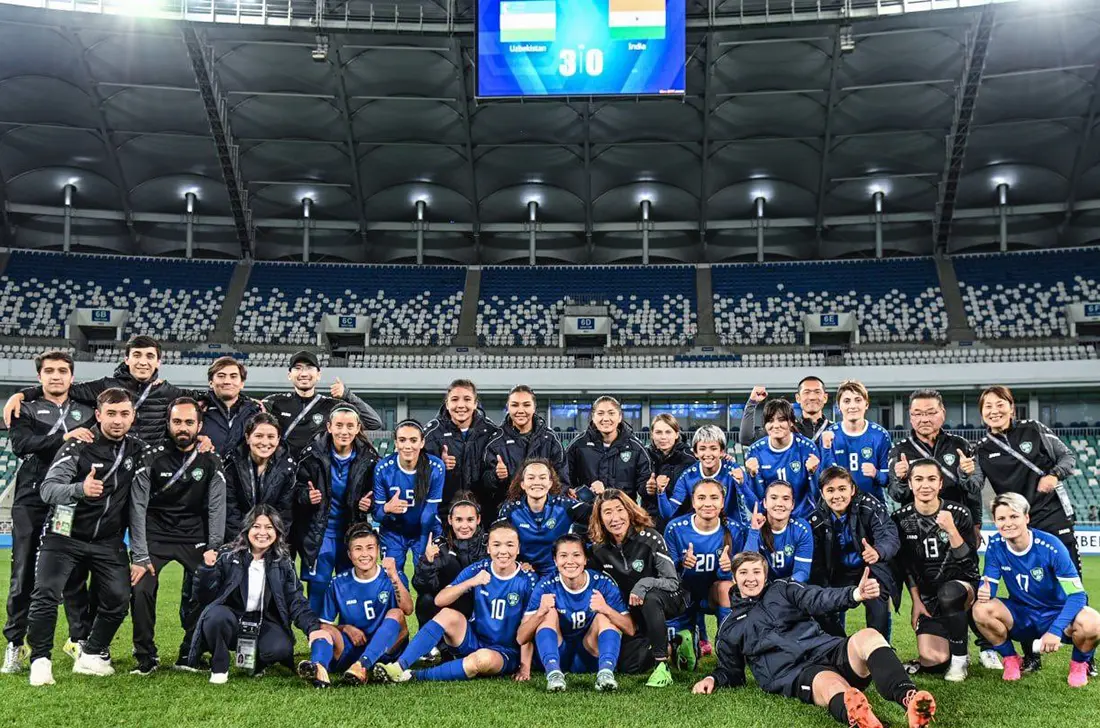
ⒸUFA
- ITO: What were some of the joys and challenges you experienced while coaching the national team?
-
Honda: It was hard to convey what we regard as common knowledge in Japan. It was hard to improve the players in the short period of time. But I never imagined we would be able to take on the national teams of Japan and the US, which is regarded as a powerhouse. We also got to participate in the Asian tournament. I had lots of experiences I could only have had with a national team.
- ITO: What are your expectations for the Uzbekistan women’s national team in the future?
-
Honda: It’s a country with huge potential. Some players are 180 cm tall and impressive jumpers. It’s common there for athletes to get married around the age of 20 and quit competing, but after I started coaching them, some of the players returned to competition even after getting married. That surprised some of the people there, but if this trend keeps building, the possibilities for the team will keep growing.
I worked with the national team for just two years, but we managed to advance to the final Asian qualifiers for the world competition. One more win, and we would have made it. I was happy that the players were serious about taking on the challenge of achieving their goal. With proper preparation, I think they have the ability to get through the Asian qualifiers in the near future. I hope they’ll keep trying.
- ITO: Ms. Nishii, what do you think you gained from your work with the Uzbekistan national team?
-
Nishii: I couldn’t accompany them all the time. I felt the difficulty of generating concrete results in the limited time I was given, but it was a revelation to learn that that wasn’t impossible. It wouldn’t have been possible without the understanding and cooperation of the team staff. I think I was able to absorb the coach’s words and convert them into tangible form. When we first came to Japan, it was touch and go whether the team would even be able to compete successfully against Japanese university students, and I never imagined they’d get to within one victory of participating in the world competition. The growth of both the players and the team was impressive.
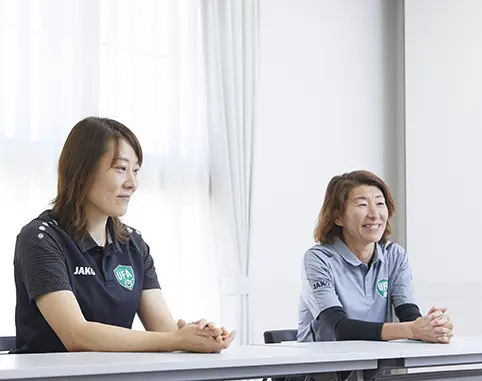
- ITO: Ms. Honda, having returned to Japan, you’ve been coaching once again at SHIZUOKA SSU BONITA. What are your goals for the future?
-
Honda: I’ve signed a contract with J.LEAGUE’s Júbilo IWATA, and I’m coaching BONITA under a secondment arrangement. IWATA hasn’t been active in women’s soccer, but they suggested I should become involved in promoting it. The establishment of the WE League as a professional league in 2021 led to men’s clubs like Omiya and Hiroshima creating women’s teams. Moves like that significantly boosted the visibility of women’s soccer. I want to boost the appeal of the city of Iwata by promoting women’s soccer while fostering good relationships between Júbilo IWATA and SHIZUOKA SSU BONITA.
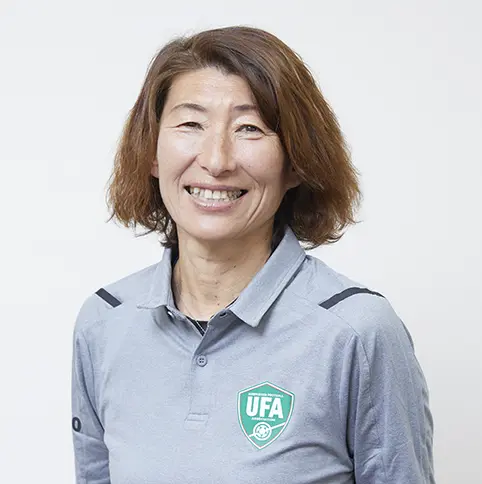
Born November 16, 1964 in Shizuoka Prefecture.
Women’s Soccer Supervisor, Hometown Co-creation Department, Júbilo IWATA Business Division / SHIZUOKA SSU BONITA Coach
She began playing soccer in the third grade of elementary school and was selected for the Japanese national women’s team in her second year of high school. She played for the Japan national team for over a decade.
After retiring as a player, she pursued a career in coaching and became the first woman to obtain a class S coaching badge from the JFA. She has served as a coach for OKAYAMA YUNOGO BELLE, the Universiade Japanese Women’s National Team, AC NAGANO PARCEIRO LADIES, and SHIZUOKA SSU ASREGINA (now SHIZUOKA SSU BONITA). In January 2022, she became coach for the Uzbekistan women’s national team, leading them to the final qualifiers for the Paris Olympics within a brief two-year timeframe.
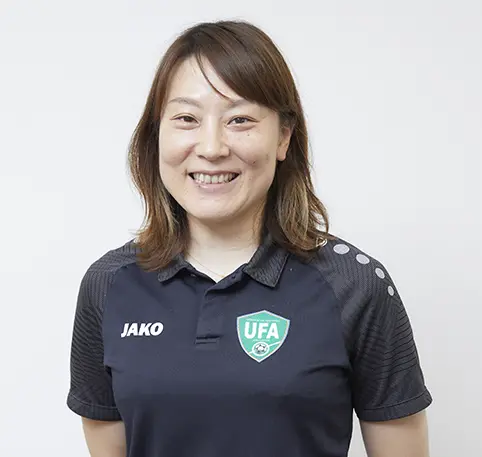
Born May 11, 1977 in Shizuoka Prefecture
Certified Athletic Trainer/Acupuncturist by the Japan Sport Association
Employee at Medical Sports Meister
She began playing basketball in elementary school, excelling in national competitions throughout junior high school, high school, and college. Her desire to become a trainer was inspired by her struggles with injuries during her time as a player.
She has accompanied J.LEAGUE players as a personal trainer on trips in Japan and overseas. She has also worked with the Theatre de Ballet Company, NEC PLATFORMS Red Falcons (women’s softball team), the Seiko Corp’s women’s softball team, SHIZUOKA SSU BONITA, and DELIZIA IWATA (futsal team), among others.
From 2022 to 2024, alongside Hidemasa Kawasaki, representative of Medical Sports Meister, she served as physical coach and athletic trainer for the Uzbekistan women’s national team.
